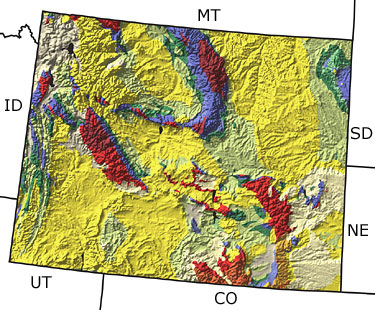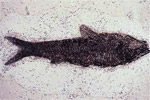Wyoming, US
|
|
|||||||||||||||||||||||||||||||||||||||||||||||||||||||||||||
Paleontology and geology
The Precambrian: Precambrian metamorphic and igneous rocks are exposed along the length of the Rocky Mountains in Wyoming. Stromatolites and some possible trace fossils have been found in metamorphosed Precambrian sediments in the southeastern part of the state. These rocks were originally formed from limy sediments deposited on a shallow sea floor.
The Paleozoic: The Paleozoic is characterized by fluctuating sea levels. A shallow sea covered Wyoming during the Early Paleozoic, and fossils of trilobites, brachiopods and other marine organisms are found in the sandstones, shales, and limestones laid down at this time. The sea retreated in the Silurian, and the state underwent an interval of uplift and erosion before marine conditions returned in the Devonian. A shallow sea persisted through much of the rest of the Paleozoic, and a diverse assemblage of invertebrate animals inhabited the marine environments. The sea began to retreat once again during the Permian.
The Mesozoic: The sea continued to retreat during the Triassic. Sediments accumulated in nearshore marine environments and then on vast river floodplains that developed as the sea regressed. Eventually, wind-blown sand dunes formed. Jurassic sediments were deposited during several transgressions and regressions of shallow marine water over Wyoming. Marine rocks are rich in fossils of oysters, belemnite cephalopods, and other marine invertebrates, while bones and trackways of dinosaurs are common in the deposits of the vast river floodplains at the edge of the sea. The Western Interior Seaway spread through much of the state during the Cretaceous, and a series of mountain-building episodes (the Laramide Orogeny) began. Cretaceous fossils include fish, turtles, crocodiles, pterosaurs, mammals, birds, and, of course, dinosaurs.
The Cenozoic: Early Cenozoic (Tertiary) climates favored the growth of luxurious forests, and fossil plants and coal deposits are common in many Tertiary formations. Lakes formed in many of the intermountain basins, and the resulting sediments often contain abundant, beautifully preserved fish fossils, including the Wyoming State Fossil, Knightia eocaena. The Rockies continued to rise and large volcanic eruptions periodically deposited thick layers of ash across the state. Late Cenozoic (Quaternary) rocks in Wyoming are predominantly the result of volcanic activity, but glaciation also produced sediments, predominantly in the western part of the state. Microfossils have been recovered from glacial lake sediment and fossils of numerous vertebrates have been found in northern Wyoming.
Links to more on Wyoming paleontology
Careers | Organizations | Education and Exhibits | Research and Collections | Resources
CareersOrganizationsDegree and Certificate Programs (showing 1 of 1 listings)
Paleoclimatology, Paleoecology, and Paleontology: The vertebrate paleontology program at UW is outstanding, with faculty holding joint appointments in the Department of Geology and Geophysics and the Department of Zoology and Physiology. Recent studies have included exploration of amber deposits in the nearby Hannah Basin, and the integration of paleontological data with stratigraphy and structural geology.
Education and ExhibitsParks (showing 1 of 1 listings)
Fossil Butte National Park: Designated a national park in 1972, Fossil Butte has preserved some of the most fossil-rich exposures of the Green River Formation for all to see. At this website, you can find information on the fossils and rocks in the park, as well as how to get there.
Government Agencies (showing 1 of 1 listings)
Wyoming State Geological Survey: Find out more about the geological, paleontological, mineral, and energy resources of Wyoming. Maps and publications about Wyoming and the state's resources can be found for sale.
Research and CollectionsVirtual Exhibits (showing 2 of 2 listings)
Localities of the Eocene: The Green River Formation: Visit this exhibit for more information on the rocks, fossils, and history of research of the Green River Formation, including references. Explore other exhibits on the UC Museum of Paleontology site to find out about the Tertiary period and the animals that lived during that time.
Paleo Video: A modern day dinosaur extinction: This video features Mark Goodwin and Jack Horner's research on pachycephalosaurs. They argue that there were fewer pachycephalosaur species in the Hell Creek Formation than we thought - two species, Dracorex hogwartsia and Stygimoloch spinifer, are actually juveniles and teenagers of the species Pachycephalosaurus wyomingensis.
Physical Exhibits (showing 2 of 2 listings)
The Red Gulch Dinosaur Tracksite: This webpage contains information on on the Red Gulch Dinosaur Tracksite, a locality in north-central Wyoming that contains over 1000 tracks of a bipedal, medium-sized dinosaur. Learn about current research at the site, site paleontology, and how to visit the location.
University of Wyoming Geological Museum: An excellent museum that has "Big Al" the Allosaurus from the BBC "Walking with Dinosaurs" fame, an Apatosaurus, along with numerous other paleontological specimens. The 2nd floor contains mainly geological displays, such as minerals, rocks, and other displays about Wyoming and regional geology. School groups can contact the museum for tours.
ResourcesOngoing Research Projects (showing 1 of 1 listings)
Bridger Basin Project: Ongoing field research in the Bridger Formation of southwestern Wyoming seeks to document the stratigraphy and depositional environments of this highly fossiliferous middle Eocene rock unit, as well as the biostratigraphy, biochronology, and evolutionary relationships of its abundant and exquisitely preserved fossils.
Field Guides (showing 2 of 2 listings)
Green River Paleobotany Project: This site is geared towards amateurs and professionals who collect fossil plants from the Parachute Creek Member of the Green River Formation in Colorado and Utah. The site provides an identification guide for more than 250 species of fossil plants and encourages collectors to submit images of their own fossils if they think they have found a new species.
Bliss Dinosaur Ranch: This site showcases a large number of Cretaceous fossils (Hell Creek Formation) on a private ranch on the Montana-Wyoming border. The bones of Triceratops and pachycephalosaurs have been found, as well as numerous mammal teeth.
Databases (showing 1 of 1 listings)
University of Wyoming Fossil Vertebrates Database: The Department of Geology and Geophysics' searchable database of over 40,000 vertebrate fossil specimens.

